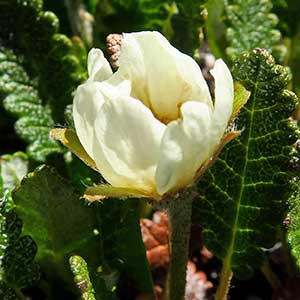Dryas hookeriana
Rosaceae tribe dryadeae
Hooker's mountain-avens, mountain avens, white dryas, White Mountain-avens
blades usually oblong-elliptic to lanceolate, sometimes ovate, 4–16(–25) × 1–6(–10) mm, base usually truncate or cordate, sometimes cuneate, margins strongly revolute to flat, coarsely dentate or serrate, sinuses 5–25(–30)% to midvein, apex acute to obtuse, surfaces smooth to slightly plicate, only midvein ± obscured adaxially within medial fold, abaxial tomentose to woolly (obscuring lateral veins), adaxial usually glabrous, sometimes sparsely hairy proximally on midvein, feathery hairs usually absent, rarely 1+ on midveins abaxially, midveins and petioles abaxially stipitate-glandular.
alternate, simple, sometimes pinnately compound or basal leaflets 1(or 2);
stipules deciduous or persistent, free or adnate to petiole;
venation pinnate.
10–30 mm.
erect at flowering;
sepals lanceolate to narrowly elliptic, 4–10 × 0.6–1.5 mm;
petals 8, spreading, usually white or cream, sometimes yellow, 9–14 × 5–11 mm;
filaments glabrous.
perianth and androecium perigynous;
epicalyx bractlets absent;
hypanthium saucer-shaped, obconic, funnelform-turbinate, or cylindric;
torus absent or hemispheric;
carpels 1(or 2) or 4–150, distinct, free, styles terminal, distinct;
ovule 1, basal (without obturator).
achenes or aggregated achenes;
styles persistent, elongate.
2.5–3 mm;
styles 11–25 mm.
= 18.
Dryas hookeriana
Rosaceae tribe dryadeae
In some states and provinces, the distribution of Dryas hookeriana is restricted to northwestern and central Colorado, southeastern and northernmost Idaho, western and central Montana, northeastern Utah (Uinta and Wasatch mountains), eastern Oregon and Washington, southwestern and central Wyoming, and western Northwest Territories.
(Discussion copyrighted by Flora of North America; reprinted with permission.)
Genera 4, species 34 (4 genera, 17 species in the flora).
Members of Dryadeae are nitrogen fixing in association with Frankia. Cyanogenic glycosides are present, and sorbitol is present in trace amounts. The base chromosome number for the tribe is x = 9 (D. Potter et al. 2007). Dryadeae is probably North American in origin.
The obturator is a placental (or funicular) outgrowth present at the micropylar end, which directs the passage of pollen tubes towards the ovule.
(Discussion copyrighted by Flora of North America; reprinted with permission.)
1. Leaves 2–3-odd-pinnately compound; inflorescences (1–)2–7(–10)-flowered, corymbs or panicles. | Chamaebatia |
1. Leaves simple or with 1(–2) basal leaflets, (margins lobed, toothed, or entire); inflorescences 1–3(–18)-flowered clusters or flowers solitary | → 2 |
2. Petals 0; hypanthia narrowly cylindric; carpels 1(or 2); achenes solitary. | Cercocarpus |
2. Petals 5–10(–12); hypanthia saucer-shaped or obconic; carpels 1–31 or 60–150; achenes usually aggregated, sometimes solitary (Purshia) | → 3 |
3. Shrubs 0.1–2.3 dm; hypanthia saucer-shaped; petals 8–10(–12). | Dryas |
3. Shrubs 2–75 dm; hypanthia obconic; petals 5. | Purshia |
- Local floras:
BC,
OR,
WA
- Local Web sites:
Flora NW,
PNW Herbaria
WildflowerSearch
iNaturalist (observations)
USDA Plants Database
- LBJ Wildflower Center
- SEINet
- Plants of the World Online
- Encyclopedia of Life
- Wikipedia
- Google Image Search


